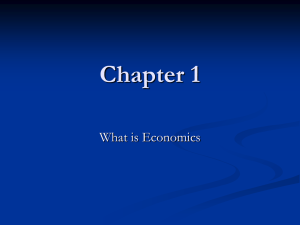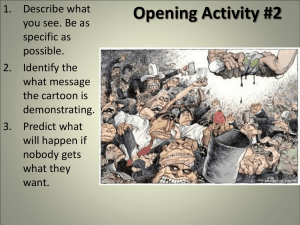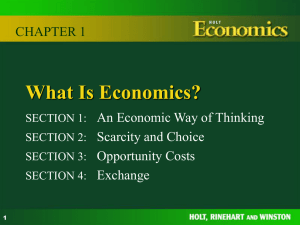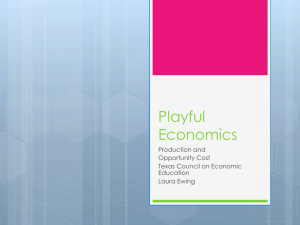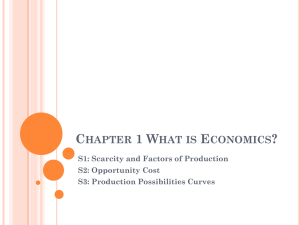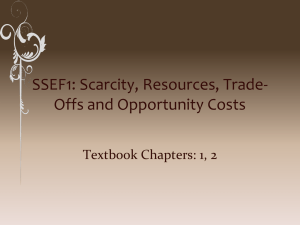Economics: Principles and Practices
advertisement
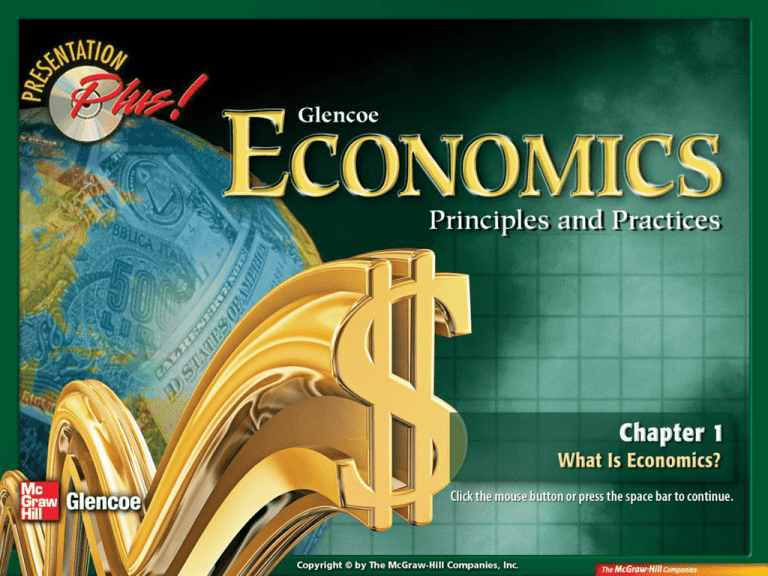
Chapter Introduction Section 1: Scarcity and the Science of Economics Section 2: Basic Economic Concepts Section 3: Economic Choices and Decision Making Visual Summary Congratulations on being selected to head up the prom committee! Now you must decide on location, music, and refreshments. What factors do you need to consider when making your choices? In groups of four, determine your budget and identify possible locations, music providers, and food. Read Chapter 1 to learn how your prom selections, like all economic decisions, require you to make choices about how to best use limited resources. Scarcity is the basic economic problem that requires people to make careful choices about how to use limited resources. Section Preview In this section, you will learn why scarcity is the basic economic problem that faces every society and why scarcity requires us to make choices. Content Vocabulary • scarcity • factors of production • labor • economics • land • entrepreneur • need • capital • want • capital good • gross domestic product (GDP) Academic Vocabulary • resource • comprehensive If the only pizza restaurant in the area produced 40 pizzas a night and usually sold out quickly, would you be willing to pay more to guarantee that you would get a pizza? B. Possibly A C. Definitely not B A. A B. B C.0%C 0% 0% C A. Definitely The Fundamental Economic Problem Societies do not have enough productive resources to satisfy everyone’s wants and needs. The Fundamental Economic Problem (cont.) • The fundamental economic problem facing all societies is that of scarcity. • Few people are satisfied with the things they have. • Society does not have enough resources to produce all the things people would like. Scarcity The Fundamental Economic Problem (cont.) • The study of how scarcity affects most decisions we make is economics. • Economists talk about people’s needs and wants. A need is necessary for survival. • A want is something we would like but not necessary for survival. The Fundamental Economic Problem (cont.) • Everything we do has a cost, due to limited resources. • TINSTAAFL—There is no such thing as a free lunch. Which do you purchase more often? A. Things you want B. Things you need A. A B. B 0% B A 0% Three Basic Questions Scarcity forces every society to answer the basic questions of WHAT, HOW, and FOR WHOM to produce. Three Basic Questions (cont.) • We live in a world of scarce resources. Scarcity means that three questions should be answered. – What to produce – How to produce – For whom to produce What is the best way to increase production of a good or service? A. Hire more employees B. Purchase more equipment B A A. A B. B C 0%C. 0% 0% C C. Replace management The Factors of Production Four factors of production— land, capital, labor, and entrepreneurs—must be present to produce goods and services. The Factors of Production (cont.) • All four factors of production are required to produce goods and services. – Land – Capital (sometimes called capital goods) – Labor – Entrepreneurs The Factors of Production The Global Economy & YOU Which of these do you think is the most important factor of production? A. Land B. Capital C A 0% A. A B. B 0% C 0% C. B C. Entrepreneurs The Scope of Economics Economics analyzes how societies satisfy wants through careful use of relatively scarce resources. The Scope of Economics (cont.) • Economics is a social science—it deals with the behavior of individuals as they satisfy unlimited and competing wants through careful use of scarce resources. The Scope of Economics (cont.) • Four key elements to the study of economics – Description • Gross domestic product (GDP) is a key measure of a nation’s economic output. – Analysis – Explanation – Prediction Which of the following does economics describe? A. Jobs A 0% 0% D D. All of the above C C. Government spending A. A B. B C. C D. 0%D 0% B B. Taxes Section Preview In this section, you will learn about some key economic terms and concepts. Content Vocabulary • good • consumer good • paradox of value • utility • durable good • wealth • nondurable good • market • service • value • factor market • productivity • human capital • division of labor • specialization • economic interdependence • product market • economic growth Academic Vocabulary • transferable • accumulation • mechanism Do you think of “big business” or large corporations when you hear the word economics? A. Always B. Sometimes C. Never 0% A A. A B. B C. 0% C 0% B C Goods, Services, and Consumers Economic products are goods or services that are useful, relatively scarce, and transferable. Goods, Services, and Consumers (cont.) • Economics is concerned with economic products—goods and services that satisfy our wants and needs. They command a price because they are scare and useful. Goods, Services, and Consumers (cont.) • There are different economic products that consumers use. – A good is a useful, tangible item. • Capital goods are manufactured goods used to produce other goods and services. – Consumer good – Durable good Goods, Services, and Consumers (cont.) – Nondurable good – Service is a work performed for someone. Which do you consume or indulge in more often? A. Goods B. Services A. A B. B 0% A 0% B Value, Utility, and Wealth The value of a good or service depends on its scarcity and utility. Value, Utility, and Wealth (cont.) • In economics, value refers to worth that can be expressed in dollars and cents. • Adam Smith, a Scottish social philosopher, came up with the term paradox of value in 1776. Value, Utility, and Wealth (cont.) • Scarcity by itself does not fully explain how value is determined. • For a good or service to have value, it must also have utility, which varies by person. Value, Utility, and Wealth (cont.) • A nation’s wealth is comprised of all tangible goods. • This, however, does not mean that services are not useful or valuable. Which of the following has the most value and utility to your family? A. Automobile B. Kitchen appliances C A 0% A. A B. B 0% C 0% C. B C. Television The Circular Flow of Economic Activity The economic activity in markets connects individuals and businesses. The Circular Flow of Economic Activity (cont.) • The circular flow of economic activity generates wealth. • The market is the key to this circular flow. • Individuals earn their incomes in factor markets. The Circular Flow of Economic Activity The Circular Flow of Economic Activity (cont.) • After individuals earn their incomes in factor markets, they spend it in product markets. • Businesses then use this money to produce more goods and services. • This cycle of economic activity repeats. In which market does your school engage? A. Cyberspace B. Local C. National D. All of the above 0% A A. A B. B C. 0% C 0% D. D B C 0% D Productivity and Economic Growth A nation’s economic growth is due to several factors. Productivity and Economic Growth (cont.) • When the circular flow becomes larger, with more factors of production, goods, and services flowing in one direction and more payments in the opposite direction, there is economic growth. – Productivity is the most important factor contributing to economic growth. Productivity and Economic Growth (cont.) • Ways to increase productivity – Invest in human capital such as education, training, and health-care – Division of labor and specialization Profiles in Economics: Adam Smith Effect of Education on Income Productivity and Economic Growth (cont.) • The U.S. economy has a remarkable degree of economic interdependence. As a result, events in one part of the world may have a dramatic impact here. Which investment we make today will generate higher returns in the future? A. Education B. Health-care 0% C A C. Technology B A. A B. B C. C 0% 0% Section Preview In this section, you will learn that you face tradeoffs and opportunity costs whenever you make an economic decision. Content Vocabulary • trade-off • opportunity cost • production possibilities frontier • economic model • cost-benefit analysis • free enterprise economy Academic Vocabulary • alternative • assumption • standard of living Are you a good decision maker? A. Always B. Sometimes C. Never C B A 0% A. A B. B 0% C 0% C. Trade-Offs and Opportunity Cost Economic choices involve trade-offs and the careful evaluation of opportunity costs. Trade-Offs and Opportunity Cost (cont.) • There are alternatives and costs to everything we do. • Every decision has trade-offs. Jesse’s Decision-Making Grid Trade-Offs and Opportunity Cost (cont.) • Similarly, each decision has an opportunity cost. – Even time has an opportunity cost. Is using a decision-making grid one way to analyze an economic problem? A. True B. False A. A B. B 0% A 0% B Production Possibilities Economies face trade-offs when deciding what goods and services to produce. Production Possibilities (cont.) • Economists use the production possibilities frontier to illustrate opportunity cost. Production Possibilities Frontier Production Possibilities (cont.) • This diagram takes into account various factors. – Identifying possible alternatives – Fully employed resources – The cost of idle resources Production Possibilities (cont.) – Opportunity cost – Economic growth Opportunity Cost Economic Growth Does the production possibilities frontier show the minimum combinations of goods and services that can be produced? A. Always A 0% C C. Never A. A B. B C.0% C 0% B B. Sometimes Thinking Like an Economist Economists use a strategy called cost-benefit analysis to evaluate choices. Thinking Like an Economist (cont.) • Economists are concerned with helping people make the best choices. Thinking Like an Economist (cont.) • Economists use two strategies: – Building models • An economic model is a simplified equation, graph, or figure based on assumptions. – Cost–benefit analysis • Investing in projects that give the highest return per dollar spent Which of the following qualifications is not necessary for a career in economics? A. Strong computer and quantitative skills C 0% A C. Ability to write reports based on complex research A. A B. B 0% C 0% C. B B. Master’s degree The Road Ahead The study of economics helps people become better citizens. The Road Ahead (cont.) • Through studying economics – We get a better understanding of the workings of a free enterprise economy. – Our standard of living is based on supply and demand, pricing, productivity, property rights, inflation, and economic growth, among other factors. The Road Ahead (cont.) – We become better decision makers in our personal lives and in the voting booth. • Most of our political problems have important economic aspects. – Economics helps us understand the complex world around us by providing a framework for analysis. Do you ever hear political candidates debate economic issues? A. Always B. Sometimes C. Never 0% A A. A B. B 0% C 0% C. B C Scarcity Because of scarcity, society needs to decide how to distribute limited resources to satisfy seemingly unlimited wants and needs. Factors of Production Four factors of production are required to produce the things we would like to have. Trade-offs and Opportunity Costs All economic decisions require us to make choices among alternatives. Trade-offs are all the available alternatives. The opportunity cost is the next-best alternative we give up. Adam Smith (1723–1790) • introduced the idea that the division of labor led to the great prosperity of Britain • defined the wealth of a nation as the sum of the goods produced by its people Economic Concepts Transparencies Transparency 1 Scarcity Transparency 2 Opportunity Cost & Trade-Offs Transparency 3 Productivity Select a transparency to view. scarcity fundamental economic problem of meeting people’s virtually unlimited wants with scarce resources economics social science dealing with the study of how people satisfy seemingly unlimited and competing wants with the careful use of scarce resources need basic requirement for survival, including food, clothing, and shelter want something we would like to have but is not necessary for survival factors of production productive resources that make up the four categories of land, capital, labor, and entrepreneurs land natural resources or other “gifts of nature” not created by human effort capital tools, equipment, and factories used in the production of goods and services capital goods tools, equipment, and factories used in the production of goods and services labor people with all their efforts, abilities and skills entrepreneur risk-taking individual in search of profits gross domestic product (GDP) dollar value of all final goods, services, and structures produced within a country’s borders during a one-year period resource any available means for economic or political development comprehensive covering many or all areas good tangible economic product that is useful, relatively scarce, and transferable to others consumer good good intended for final use by consumers rather than businesses durable good a good that lasts for at least three years when used regularly nondurable good a good that wears out or lasts for fewer than three years when used regularly service work or labor performed for someone value monetary worth of a good or service as determined by the market paradox of value apparent contradiction between the high monetary value of a nonessential item and the low value of an essential item utility ability or capacity of a good or service to be useful and give satisfaction to someone wealth sum of tangible economic goods that are scarce, useful, and transferable from one person to another market meeting place or mechanism that allows buyers and sellers to come together factor market market where the factors of production are bought and sold product market market where goods and services are bought and sold economic growth increase in a nation’s total output of goods and services over time productivity measure of the amount of output produced with a given amount of productive factors human capital sum of people’s skills, abilities, health, knowledge and motivation division of labor division of work into a number of separate tasks to be performed by different workers specialization assignment of tasks to the workers, factories, regions, or nations that can perform them more efficiently economic interdependence mutual dependency of one person’s, firm’s, or region’s economic activities on another’s transferable able to be moved from one person or place to another accumulation gradual collection of goods mechanism process trade-off alternative that is available whenever a choice is to be made opportunity cost cost of the next-best alternative use of money, time, or resources when making a choice production possibilities frontier diagram representing the maximum combinations of goods and/or services an economy can produce when all productive resources are fully employed economic model simplified version of a complex concept or behavior expressed in the form of an equation, graph, or illustration cost-benefit analysis way of thinking about a choice that compares the cost of an action to its benefits free enterprise economy market economy in which privately owned businesses have the freedom to operate for a profit with limited government intervention standard of living quality of life based on ownership of necessities and luxuries that make life easier alternative the second of two choices assumption something taken for granted To use this Presentation Plus! product: Click the Forward button to go to the next slide. Click the Previous button to return to the previous slide. Click the Home button to return to the Chapter Menu. Click the Transparency button from the Chapter Menu, Chapter Introduction, or Visual Summary slides to access the Economic Concepts transparencies that are relevant to this chapter. From within a section, click on this button to access the relevant Daily Focus Skills Transparency. Click the Return button in a feature to return to the main presentation. Click the Economics Online button to access online textbook features. Click the Reference Atlas button to access the Interactive Reference Atlas. Click the Exit button or press the Escape key [Esc] to end the chapter slide show. Click the Help button to access this screen. Links to Presentation Plus! features such as Graphs in Motion, Charts in Motion, and figures from your textbook are located at the bottom of relevant screens. This slide is intentionally blank.


